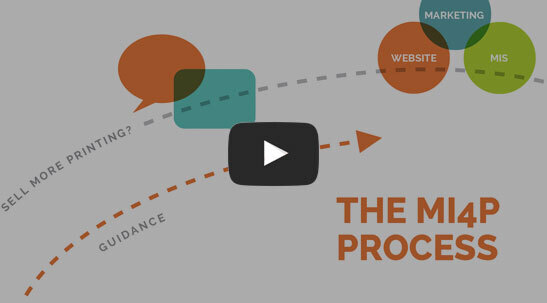E-Commerce for Printers: Should I Put My Prices on My Website?

By the end of 2019, it’s estimated that there will be 224 million digital shoppers in the United States alone.
That statistic is shoppers, not orders. How many orders do you think 224 million shoppers place annually? A lot — as in that’s-a-whole-lot-of-numbers-math-is-hard kind of a lot.
But, if you think about it, online order numbers like that shouldn’t surprise most of us.
We’ve all been known to engage in a seek-and-destroy online shopping experience while in our pajamas using our weapon of choice: our index fingers. That tactic seems to make way more sense than actually getting off the couch, driving somewhere, and becoming a participating member of the retail world in person.
Seriously, why would you do all that work when what is needed is right at your fingertips?
Since more and more people are opting for online shopping, it’s pretty easy to conclude where your focus needs to be for selling printing. It needs to cater to your online storefront.
The Pricing “What Ifs”
For many small businesses, one of the biggest hold-ups for selling online is the debate of whether or not to put your product pricing on your website.
After all, there are so many “What ifs…” when it comes to pricing, right?
For those small to mid-sized printers, many of them hold firm to the belief that price is an area where they can’t compete. The fear of having their website visitors see their prices and run the other direction leaves them to believe that keeping their prices hidden will at least give them a fighting chance.
Other printers take a different approach and believe so strongly that they shouldn’t be judged on price alone, they’ll do all they can to make sure it’s a non-issue.
But, is it?
What’s the Big Deal About Pricing?
Whether you agree with it or not, the truth is, pricing is a big deal and avoiding it isn’t the way to go.
Think about it: when you go to purchase something online, don’t you want to know the price? Don’t you want to know what it will cost you and if that cost equals the value you received?
We are all programmed to check the price of something. We use the price as ONE way (not the only way) to access whether or not we got a good deal, if it was worth it, to plan accordingly if we do pursue it, etc.
To put it another way, when your wife or husband brings home an unexpected purchase, you probably don’t ask about the value it will bring her (well, okay, you might). But, more than likely, you’ll also ask him/her how much it cost. Is that because you’re a horrible spouse and casting judgment? Of course not. It’s because you want to adjust your finances to accommodate for what they find value in and plan accordingly. Or, you want to ensure they were well taken care of and received a quality product for the monetary request asked of them.
How Not Listing Prices Translates to Your Audience
When you make the choice not to list your prices online, you need to understand the impression you’re leaving with your website visitors. Consider the following:
- When consumers can’t find a price quickly, they’ll move on… as in, on to your competition. Your “fighting chance” begins when you stop conceding to the competition by allowing prospects to overlook you because they don’t have the information they’re searching for.
- Even if your price is higher, you’ll get a better result by listing your price because it at least begs the question, “Why? Why is the price higher? Is it higher quality? Maybe I should research this more to find out what added value they’re bringing.”
- No listed prices scream to your prospects, “This is going to be expensive. If I have to ask, there’s a good chance I can’t afford it anyway.”
- You’re going to have to tell your customers eventually anyway. Wouldn’t it be better to do it up front and on your own terms without leaving room for surprises later?
You Can Compete, and Here’s How
When you feel you can’t compete on price, what do you do?
You focus on your differentiator.
You might think you’re “just” a printing company that’s “just like every other printing company,” but are you really?
- Do you have a better sales process?
- Do you take better care of your customers?
- Are you more experienced in wide format, digital, or offset printing than your competitors, meaning they come to you when they want it done right?
When you know what sets you apart, you can be proud of your prices because you know you’re worth what you’re asking.
“Perhaps the reason price is all your customers care about is because you haven’t given them anything else to care about.”– Seth Godin, best selling author and marketing guru [All Marketers Are Liars, 2005]
If, on the other hand, you truly think you might be charging too much for the product but have to because of your own financial needs, think through ways that you can keep your current price but add additional value. Can you create a smoother ordering experience by creating a custom portal? Can you offer greater efficiency with a reorder library?
Embrace your value by being open and honest about why your prices are higher. By all means, even blog about it! Because it’s a common trend for company owners to shy away from talking about price, you’ll probably even boost your SEO!
Then, go even further by proving it. Add some testimonials on or near your pricing so you can show that others believe you’re worth the cost as well.
It’s All About Perception
If you do decide to implement an E-Commerce Suite on your website, remember that pricing is all about perception. When you think through pricing structures for your products or services, research effective ways to create a good perception. Here are some tips to get you started:
- Reducing the left digit of your price by one will lead to a better conversion rate for you. For example, if you’ve set your price for 500 business cards at $40.00, reducing it to $39.99 will get you better results.
- Prices displayed in smaller fonts will automatically make your brain think the price is smaller than it is. The reverse of this is true as well. Big fonts for discounts and deals. Small fonts when you want the price to seem not as big.
- Ditch the comma. Along the same lines as using smaller fonts, when you remove the comma in a number, the number is perceived as smaller. Which looks bigger to your brain: $1,300 or $1300?
- Consider the syllables. Did you know your brain subconsciously thinks words with fewer syllables are smaller? Even when reading a price, the amount with the fewer syllables will make your brain consider it smaller. For example, $27.95 (7 syllables) will sound bigger to your brain than $28.15 (5 syllables).
Remember, as Katharine Paine says, “The moment you make a mistake in pricing, you’re eating into your reputation or your profits.”
What do you think about listing your printing prices online? Let us know below.

